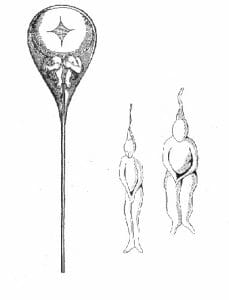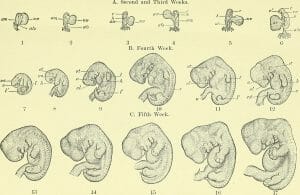Embryology Definition
Embryology is the branch of biology concerned with the development of new organisms. Embryologists track reproductive cells (gametes) as they progress through fertilization, become a single-celled zygote, then an embryo, all the way to a fully functioning organism. There are many subdivisions of embryology, some scientist focusing on human embryos, while others study animals and plants. Evolutionary biologists often use embryology as a means of comparing species, as the development of an organism can give many clues to its evolutionary history. Still other scientists use embryology as a tool to better understand the system or organism they are dealing with, be it conservation of an endangered species or the reproductive disruption of a pest species. Scientists studying human embryology assist with women’s reproductive health, and understand the broad scope of issues which can lead to developmental defects and malformations.
History of Embryology
Early scientists and philosophers were not ignorant, and were aware of sperm as soon as the microscope was invented. However, there have been competing theories in early embryology. The first notions of embryology are as old as the classical philosophers. Aristotle first proposed the correct mechanism for the development of an embryo, without having a microscope to observe his theory. Aristotle suggested that animals form through the process of epigenesis, in which a single cell divides and differentiates into the many tissues and organs of an animal. However, without evidence, a theory is really only a guess.
A second theory, preformation, gained much traction before the invention of microscopes and more advanced imaging techniques. This idea suggested that the embryo was contained, small but fully formed, inside the sperm. An image of this theory can be seen above. This theory also suggested women were simply vessels to carry the growing child, and that girls came from the left testicle, while boys came from the right. Knowing modern biology, it is obvious that this theory is incorrect. At the time, though, lack of proof and religious overtones into science pushed this rather sexist and equally unproven idea. When the microscope finally was invented, one of the first things people looked at was sperm. The sperm were magnified to the limits of early microscopes, and no fully formed small babies were ever found. But, this failed to fully convince the preformation supporters that epigenesis was the right answer.
It wasn’t until 1827 that clear evidence was obtained that female mammals also produce a sex cell, the ovum. The discovery of a female sex cell directly contradicted many aspects of the preformation theory, and led to wider acceptance of the epigenesis theory. Karl Ernst von Baer, discoverer of the ovum, and Heinz Christian Pander then proposed the theory which is still at the heart of embryology today. That theory is the germ layer theory, which postulates that a single cell becomes separate layers of cells as the early organism divides. These germ layers then give rise to the rest of the organism by growing and folding into organs, vessels, and other complex tissues and the cells within differentiate accordingly.
A few more advancements would fully establish the germ layer theory into embryology. The discovery and understanding of DNA led to a more comprehensive understanding of how sperm and egg become a zygote. The development of ultrasound greatly increased the understanding of fetus development in humans, seen in the above image. Many studies were done on simple organisms to understand basic embryology. The flat worm was cultured intensively, as it reproduces sexually and the cells are large enough to watch develop under a good microscope. The fruit fly was also observed extensively, for similar reasons. Studying a polychaete worm, E.B. Wilson developed a coding process to label and understand the movements and divisions of cells during embryogenesis. While the exact process changes depending on the species, this method greatly expedited the understanding of embryology and led to medical and evolutionary science breakthroughs.
Careers in Embryology
An embryologist is a scientist who studies embryology. Any organism that reproduces sexually must create some sort of embryo as it develops into an adult form. An embryologist may study the development of animals, plants, and even fungi. Evolutionary biologists often study embryology as a means of understanding complicated lines of evolution. For instance, all vertebrates including humans go through an embryological phase in which the precursors for gills are present. In humans, these structures develop into structures of the throat. However, the similarity between all vertebrate embryos suggests that all vertebrates arose from a common ancestor which used this form of embryogenesis. A professional embryologist may remain in academia, advancing the science of embryology, or can choose to join the medical profession.
Embryologists are needed anywhere pregnancy is handled, as pregnancy is simply human embryogenesis. Some scientists specialize in disruptions to embryogenesis which result in malformations and disorders. This is called teratology, and covers everything from miscarriages to birth defects. Doctors can specialize solely in embryology and teratology or may choose to cover a broader range of women’s health issues.
Many professions employ knowledge of embryology in their practices. Many pharmaceutical companies develop drugs for both fertility and sterility, and the processes of embryology are key to these efforts. Scientists developing insecticides, or ways to deal with other pests, often turn to embryology to battle the reproductive cycles of the organisms. This is often the most cost-efficient way to battle a large pest problem. Others use embryology for the advantage of a species, like the scientists trying to repopulate endangered species. For instance, researchers at several institutions across the United States are teaming up to save the Black-Footed Ferret. They must understand ferret embryology to fully be successful, as well as their behavior, diet, and mating habits. This is a good example of how embryology plays a small but very important role in a larger scientific endeavor.
References
- Brusca, R. C., & Brusca, G. J. (2003). Invertebrates. Sunderland, MA: Sinauer Associates, Inc.
- Hyttel, P., Sinowatz, F., & Vejlsted, M. (2010). Essentials of Domestic Animal Embryology. China: Elsevier Limited.
- Pough, F. H., Janis, C. M., & Heiser, J. B. (2009). Vertebrate Life. Boston: Pearson Benjamin Cummings.


